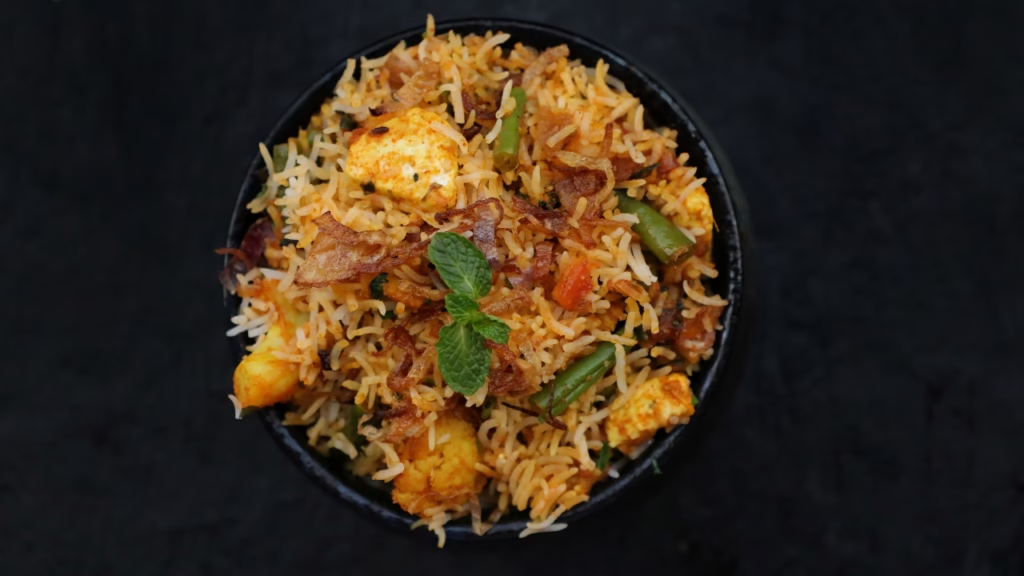Creamy, deeply spiced, and bursting with flavor, Chicken Tikka Masala has earned its place as a global favorite. While its exact origins spark debate, many agree it’s a delicious blend of Indian culinary traditions and British influence. This dish is known for its tender, marinated chicken, simmered in a rich, velvety tomato-based sauce. Whether you’re savoring it in a restaurant or making it at home, it’s a comfort food that brings people back for more. Let’s explore what makes Chicken Tikka Masala such an iconic and irresistible dish.
What is Chicken Tikka Masala?
Chicken Tikka Masala is a globally celebrated dish that masterfully combines bold spices, succulent marinated chicken, and a luscious, creamy tomato sauce. With its vibrant flavors and pleasing textures, it’s no wonder this curry has become a staple in Indian restaurants worldwide and a household favorite in kitchens. Let’s break down its essential components, flavor dynamics, and the cultural roots that make this dish truly iconic.
Key Ingredients
To create the irresistible taste of Chicken Tikka Masala, each ingredient plays a vital role:
- Chicken: Commonly prepared with skinless, boneless chicken thighs or breast pieces, the meat is marinated to ensure optimal tenderness and flavor. Yogurt in the marinade helps break down proteins while keeping the chicken moist.
- Yogurt: Used for marinating the chicken, yogurt adds tanginess and softens the meat. Spices like turmeric, cumin, and garam masala blend beautifully during this process.
- Spices: The heart of the dish lies in its aromatic spices. Ground cumin, coriander, turmeric, paprika, and garam masala are commonly used. These spices lend depth and warmth to the sauce and the chicken.
- Tomato-Based Gravy: A velvety sauce made with pureed tomatoes forms the base. Heavy cream or coconut milk is often added towards the end to create its signature creamy texture.
- Ginger and Garlic: These two staples provide a robust, savory layer of flavor that enriches both the marinade and sauce.
- Fresh Cilantro: Cilantro is usually sprinkled on at the end, offering a fresh, herbal balance to the rich, spiced curry.
Want to learn more about what goes into the perfect Chicken Tikka Masala? Check out this detailed recipe guide by Indian Healthy Recipes.
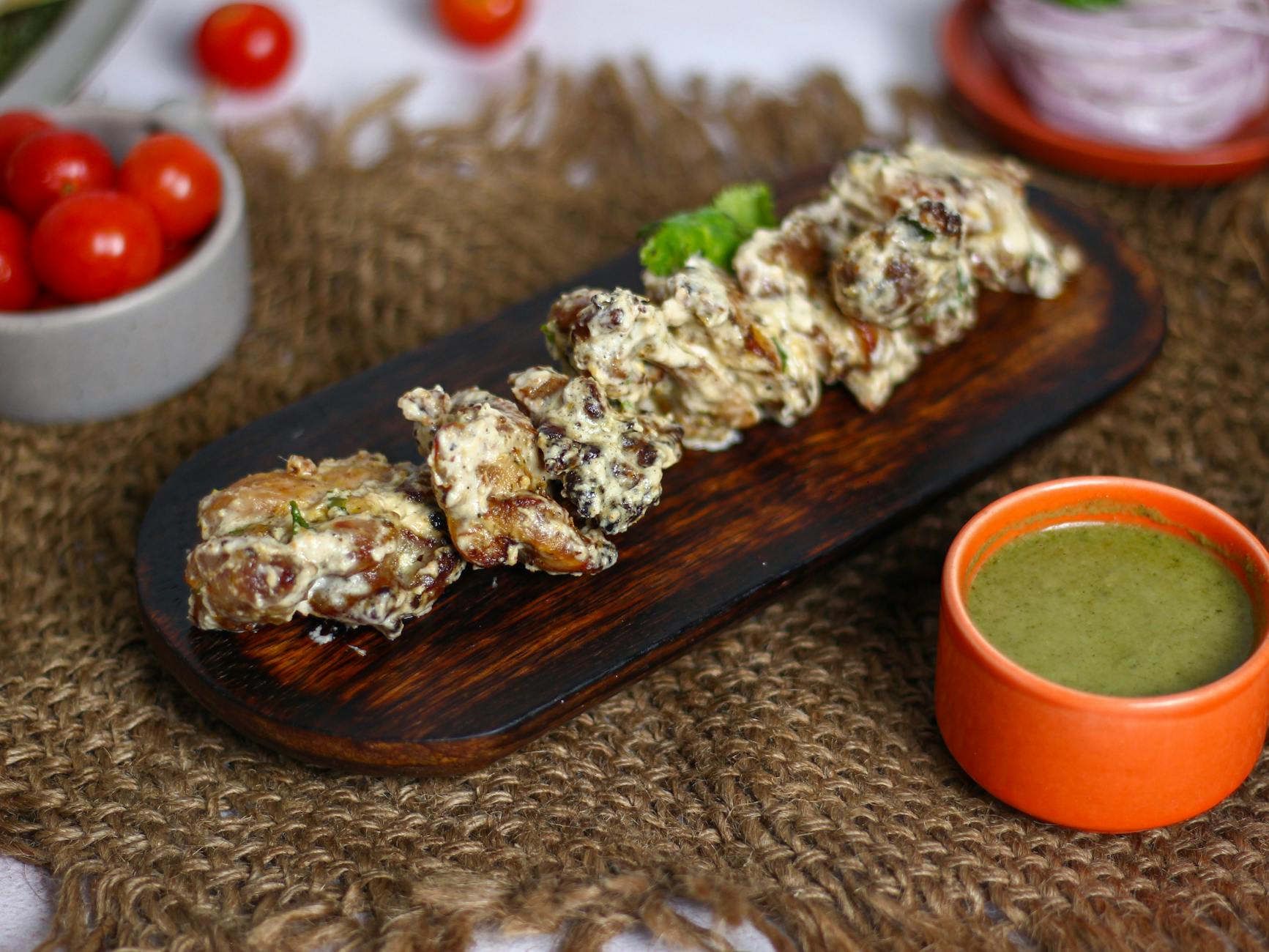
Photo by Prabal Pratap Singh
Flavor Profile
What makes Chicken Tikka Masala unforgettable? It’s the perfectly balanced interplay of flavors:
- Spicy and Aromatic: The spices pack a punch without being overwhelming, appealing to those who enjoy warmth rather than intense heat.
- Creamy and Rich: The addition of cream or yogurt adds a luxurious silkiness to the sauce that coats the chicken beautifully.
- Tangy and Sweet: The tomatoes lend a subtle tang, which is complemented by a hint of sweetness from caramelized onions or a dash of sugar.
- Smoky Undertones: When the chicken is grilled or cooked in a tandoor, it develops a smoky, charred aroma that deepens the dish’s complexity.
This harmonious mix leaves every bite as satisfying as the last. For more insights into the flavor dynamics of Chicken Tikka Masala, take a look at this article from Carlsbad Cravings.
Cultural Significance
Chicken Tikka Masala’s history is as rich as its flavor. While its precise origin is debated, many believe it emerged from the kitchens of Bangladeshi chefs working in the UK. The dish was likely created to cater to the British palate by softening traditional Indian flavors with cream and milder spices.
It has since become a beloved symbol of cultural fusion. In 2001, British Foreign Secretary Robin Cook even called it a “true British national dish,” underlining its cultural integration and significance in the UK. This cross-cultural culinary masterpiece showcases how food transcends boundaries, blending traditions to create something universally appealing.
Curious about its fascinating journey through history? Read more about its origins at Sukhi’s Guide to Chicken Tikka Masala.
The History of Chicken Tikka Masala
Chicken Tikka Masala is more than just a recipe; it’s a reflection of history, culture, and culinary evolution. Its journey from marinated meats in Indian tandoors to becoming a British food icon tells a story of flavor, creativity, and cultural fusion.
Indian Roots
The story of Chicken Tikka Masala begins with India’s rich culinary heritage. The dish is strongly rooted in the traditional Indian cooking technique of tandoori. Tandoors—clay ovens used to roast and char meats—are an integral part of Indian cuisine and provide the distinctive smokiness to dishes like tikka.
- Marination Process: The chicken is marinated with aromatic spices and yogurt. This process not only infuses flavor but also tenderizes the meat. Ingredients such as cumin, coriander, turmeric, and garam masala are staples of Indian cuisine and form the foundation of this dish.
- Layered Spices: Indian food is celebrated for its masterful use of spices. Tikka highlights bright, bold flavors that complement the smokiness of char-grilled meat, creating a balance of heat, tang, and warmth.
While Chicken Tikka stands alone as a flavorful kebab, the addition of the creamy tomato-based gravy—what many now recognize in Chicken Tikka Masala—was a later innovation.
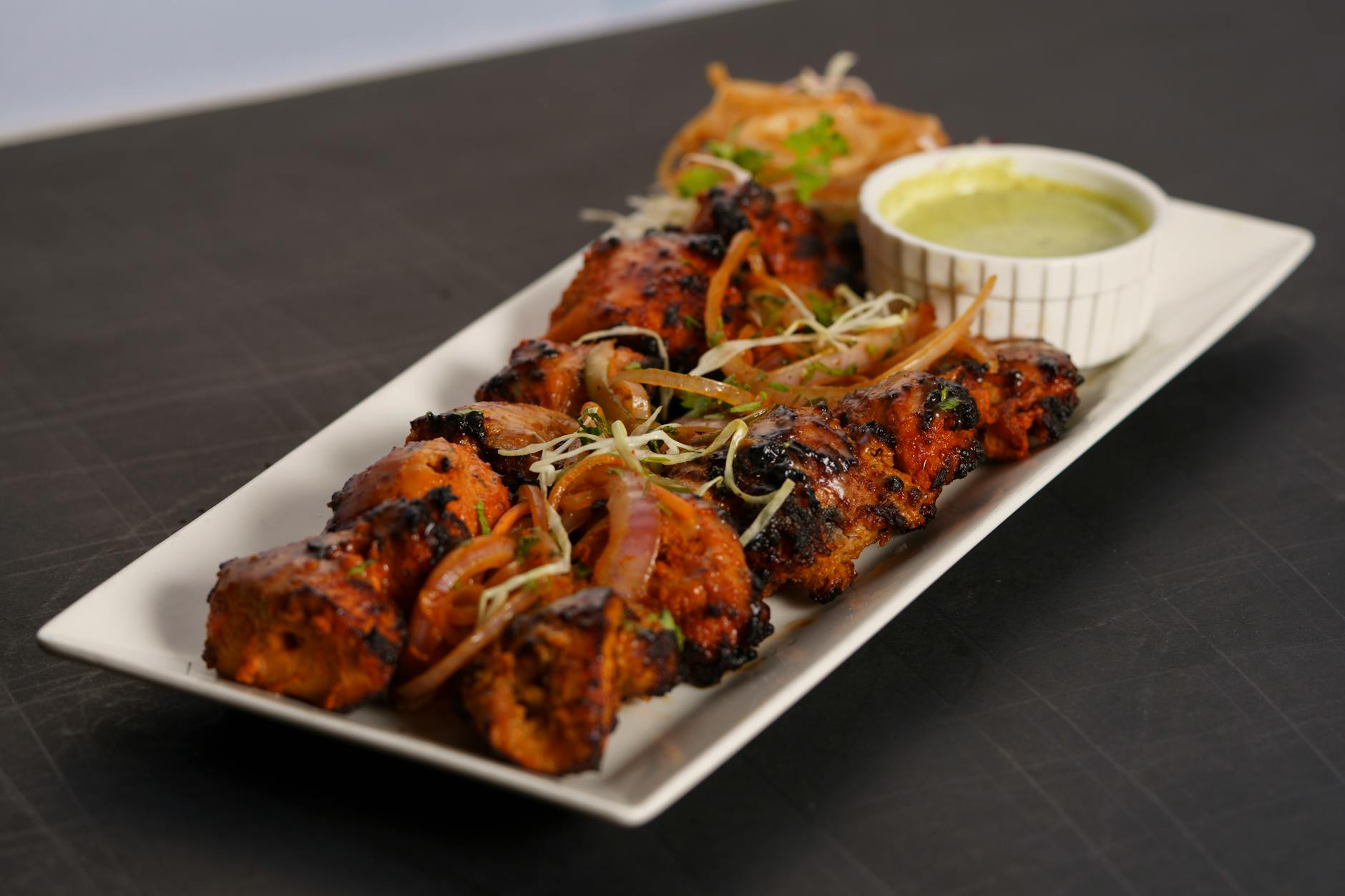
Photo by Kunal Lakhotia
Claims of Invention in the UK
The most intriguing (and debated) chapter in this dish’s history involves its creation in the UK. Many trace its origins to Bangladeshi chefs working in Indian restaurants across Britain during the 1970s. Among the most popular claims is that Ali Ahmed Aslam, a chef and owner of the Shish Mahal restaurant in Glasgow, Scotland, invented the dish. Legend has it that he created Chicken Tikka Masala after a customer found his tikka too dry and requested some gravy. In a moment of ingenuity, Aslam reportedly added a tomato-based sauce with cream and spices, thus giving birth to the modern Chicken Tikka Masala.
This culinary adaptation became a beloved choice for the British palate, marrying the robust flavors of Indian food with a milder, creamier texture. By the early 2000s, it had even been declared “a true British national dish” by former Foreign Secretary Robin Cook. This stood as a testament to its role in symbolizing multiculturalism in the UK.
For deeper insights on these claims and their cultural context, explore this fascinating history of Chicken Tikka Masala on Britannica or this article from CNN.
Global Adaptations
Over time, Chicken Tikka Masala transcended its origins, becoming a global phenomenon. What’s truly remarkable is how this dish has been adapted across different cultures:
- United States: In America, Chicken Tikka Masala often leans heavily on cream to create an ultra-rich sauce, aligning with the U.S. preference for comfort foods.
- Japan: Japanese versions may include softer, sweeter flavors, incorporating ingredients like honey or additional soy, aligning with local taste preferences.
- Middle East: Adaptations here might introduce regional spices like cardamom or saffron for a slightly aromatic twist, merging the dish with Arabic cuisine.
- Australia: The Australian take often simplifies the dish, making it more approachable with less spice but an emphasis on grilled chicken and fresh, local produce.
These adaptations reflect how Chicken Tikka Masala has evolved to accommodate regional palates while still staying true to its essence. Its story is a testament to how food bridges gaps and finds a way to unite people, no matter where it’s served. For a deeper dive into its rich global journey, check out this ultimate guide on its history by Sukhi’s.
How to Make Chicken Tikka Masala at Home
Chicken Tikka Masala is a dish that brings restaurant-quality flavor directly to your kitchen. By mastering a few key steps, you can recreate this comforting classic without leaving home. Let’s break it down and make your cooking experience as satisfying as the final dish.
Marinating the Chicken
Marination is where the magic starts. The combination of yogurt and spices isn’t just for flavor—it’s a step that locks in moisture and adds richness to the chicken.
- Choose Your Cut: Opt for boneless, skinless chicken thighs or breasts. Thighs are more forgiving to cook and stay juicier.
- Prepare the Marinade: In a medium-sized bowl, mix together:
- Plain yogurt (Greek or regular)
- Freshly grated garlic and ginger
- Ground spices like cumin, turmeric, paprika, coriander, and garam masala
- Marinate the Chicken: Coat your chicken pieces in the mixture and let them sit for at least 1-2 hours. For the best flavor, refrigerate overnight.
Why is this step so important? The yogurt tenderizes the meat, while the spices infuse it with bold flavors. Trust the process—it’s the foundation of a great dish.
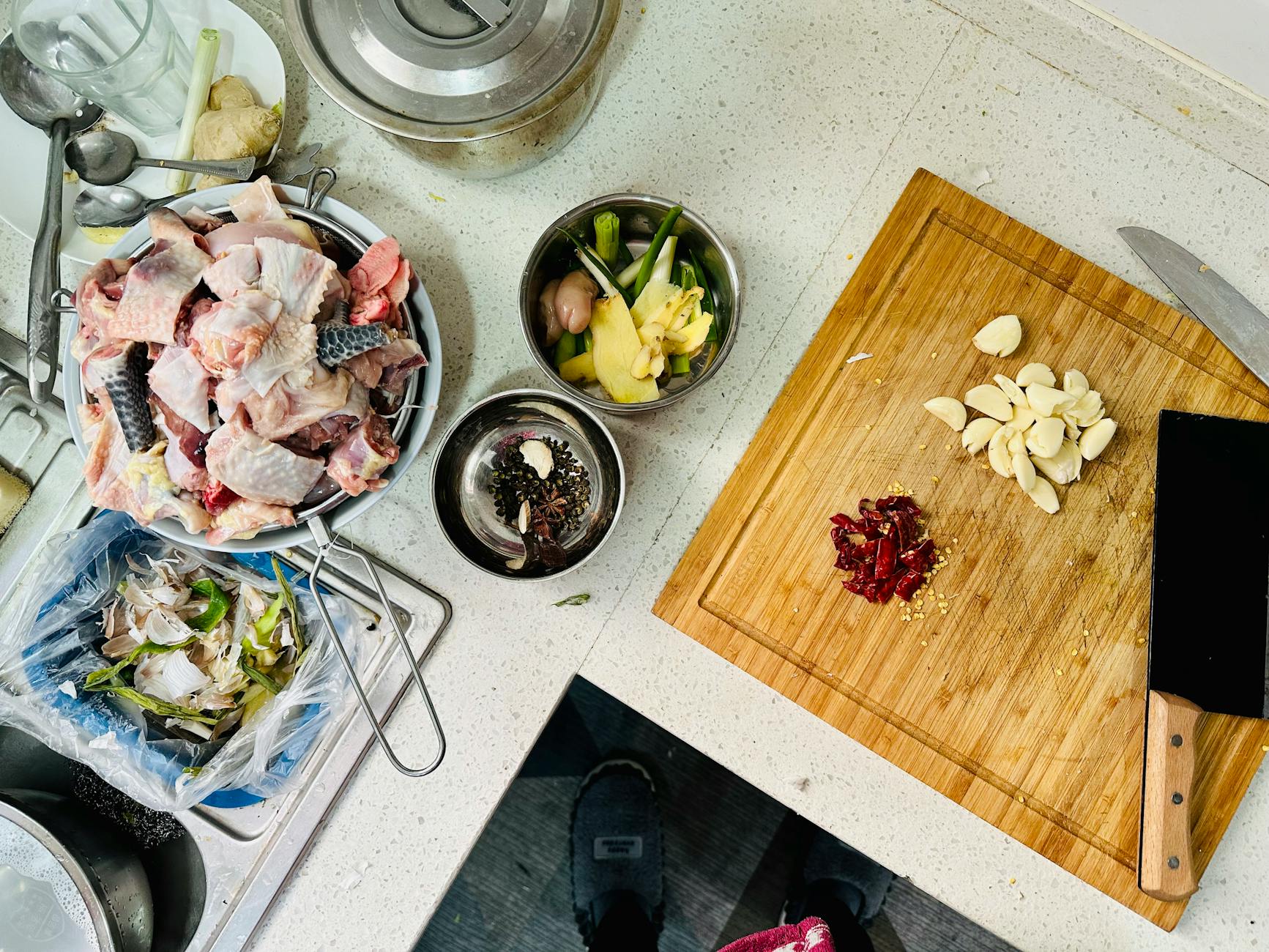
Photo by 奥尼尔 孙
Preparing the Sauce
The creamy, spiced sauce is what transforms chicken tikka into chicken tikka masala. Done right, it’s a balance of heat, tang, and creaminess.
- Core Ingredients:
- Start with finely chopped onions, garlic, and ginger.
- For the base, use pureed tomatoes or canned tomato sauce.
- Spices like garam masala, ground coriander, and Kashmiri chili powder give it warmth and depth.
- Cook the Aromatics: Heat a pan with a bit of oil or ghee. Sauté onions until golden, then add garlic, ginger, and your spices. Frying these at the start blooms their flavor.
- Combine and Simmer: Stir in the tomato base and let it simmer on low heat for 10-15 minutes. Add heavy cream or coconut milk toward the end for that signature smooth texture.
A well-crafted sauce is like the heart of the dish. Keep adjusting the seasoning until every spoonful excites your taste buds.
You can find a detailed recipe here for additional steps to get the sauce perfect.
Cooking Methods
How you cook the chicken matters. The goal is to char the pieces slightly while keeping the inside moist. Here are some options:
- Tandoor or Grill: For authentic smokiness, cook the chicken on skewers in a tandoor or grill over medium heat. Brush with oil to prevent sticking.
- Broiler: Don’t have a grill? Use your oven’s broiler. Lay the marinated chicken on a foil-lined tray and broil until slightly charred.
- Stovetop: Heat a skillet with oil and cook the chicken pieces until they’re golden and cooked through.
Each method brings something different to the table. For weeknights, stovetop cooking is quick, but grilling adds that irresistible charred flavor.
For specifics on the grilling method, check out this recipe.
Tips for a Perfect Dish
Want to elevate your Chicken Tikka Masala and wow your dinner guests? Here are a few extra tips:
- Spice Control: Add or reduce chili powder depending on your spice tolerance, but don’t skimp on other spices—they’re key to flavor!
- Finish with Butter: A small pat of butter stirred into the sauce adds richness.
- Garnish for Freshness: Sprinkle fresh cilantro leaves over the dish before serving for an herbal pop.
- Serve it Right: Pair the dish with fluffy basmati rice or handmade naan for the full experience.
Making Chicken Tikka Masala at home doesn’t have to be intimidating. By following these steps, you’ll achieve bold, restaurant-worthy flavors in the comfort of your own kitchen.
Chicken Tikka Masala Variations
Chicken Tikka Masala has solidified its place as a culinary favorite worldwide, and its adaptability is a big reason why. Whether you’re seeking plant-based alternatives, exploring global twists, or making healthier choices, this dish can cater to a variety of preferences and dietary needs.
Vegetarian and Vegan Options
For those looking to enjoy Chicken Tikka Masala without the chicken, plant-based alternatives offer delicious ways to reinterpret this classic dish. With just a few substitutions, you can create a vegetarian or vegan version that still packs all the flavor.
- Paneer Tikka Masala: Paneer, a fresh Indian cheese, is a popular option. Its firm yet soft texture soaks up the spices and creamy tomato-based sauce perfectly. Simply substitute chicken with paneer cubes and follow the same seasoning and cooking method.
- Tofu Tikka Masala: Tofu is a versatile substitute for chicken. Use firm or extra-firm tofu to ensure it holds up in the sauce. Marinate it in spices, grill or pan-fry for a slight char, and then simmer it in the curry. Check out how to make it here.
- Vegetable-Based Versions: Vegetables like cauliflower, bell peppers, or even chickpeas create hearty alternatives. Roast the vegetables beforehand for added depth and texture. This is a great way to pack in nutrients while keeping the dish light.
Whether it’s paneer, tofu, or vegetables, the goal is to maintain that balance of smoky, spiced, and creamy flavors that make this dish unique. For more ideas, you can explore Vegan Tikka Masala by School Night Vegan.
Regional Variations
Chicken Tikka Masala is beloved worldwide, but its preparation often changes based on regional ingredients and taste preferences. These adaptations give the dish a fresh personality no matter where it’s served.
- United Kingdom: The UK version, where the dish is said to have been popularized, leans heavily on cream for a velvety texture, and the spice levels are milder to suit local palates.
- India: In its Indian adaptations, the dish is often spicier and more aromatic, with a bolder emphasis on traditional spices like garam masala and cardamom.
- United States: The American take often incorporates more butter and cream, leaning toward a flavor profile similar to butter chicken but with distinct tikka spices.
- Middle East: Here, versions of Chicken Tikka Masala may include saffron or a touch of dried lime, blending Indian and Arabic flavor influences.
- Australia: Australian variations often highlight grilled chicken with reduced spice levels to appeal to broader family-friendly preferences.
Interestingly, these regional interpretations not only emphasize the versatility of Chicken Tikka Masala but also show how food becomes a medium of cultural exchange. Dive deeper into this fascinating topic with The English Kitchen’s breakdown of regional recipes.
Healthier Versions
If you love the rich taste of Chicken Tikka Masala but want a healthier spin, there are several ways to make a lighter version without losing its essence.
- Swap the Cream: Replace heavy cream with Greek yogurt, low-fat coconut milk, or even cashew cream. These options cut down on calories while retaining the dish’s signature creaminess.
- Lean Protein: Use lean chicken breast instead of thighs, or go for plant-based proteins like tofu or chickpeas for a low-fat and high-fiber alternative.
- Lighter Gravy: Opt for fresh pureed tomatoes instead of canned varieties and limit the use of butter or ghee. This simple change is an easy way to make the dish less calorie-dense.
- Spice Boost: Intensify the spices to enhance flavor. Using more turmeric, chili, or smoked paprika can add boldness, letting you scale back on calorie-heavy ingredients. Need a recipe to get started? Try this lighter option from Lite Cravings.
- Add Veggies: Throw in nutrient-rich vegetables like spinach, zucchini, or bell peppers. These not only make the dish more colorful but also add fiber and vitamins.
By making small tweaks, you can enjoy Chicken Tikka Masala guilt-free, all while keeping its comforting and satisfying spirit intact. For inspiration, explore this healthy version by Skinnytaste.
 Photo by Ahmad No More
Photo by Ahmad No More
This dish’s versatility is a testament to its global appeal, making it adaptable for nearly every diet or preference, without compromising its delightful essence.
Pairing Suggestions for Chicken Tikka Masala
When enjoying Chicken Tikka Masala, the right pairing can transform the meal into a true culinary experience. Whether it’s the fluffy perfection of basmati rice or a refreshing drink to balance the spices, picking the right accompaniments is key. Let’s explore some classic and complementary options.
Rice and Bread: Recommend traditional pairings like basmati rice, naan, or paratha
Rice and bread are the backbone of any Chicken Tikka Masala meal, providing a comforting base to soak up the creamy and flavorful sauce.
- Basmati Rice: Known for its aromatic character, basmati rice is the perfect match. Its fluffy grains complement the rich curry without overpowering it. Jazz it up with a sprinkle of saffron or a handful of toasted nuts for an added flair.
- Naan: This soft, slightly chewy bread is ideal for scooping up every last bit of sauce. Garlic naan or butter naan adds even more indulgence to the meal.
- Paratha: If you’d prefer a crispier option, paratha—a layered, flaky flatbread—provides a delightful contrast to the creaminess of the curry.
Discover more insights on these staple pairings at What To Serve With Chicken Tikka Masala.
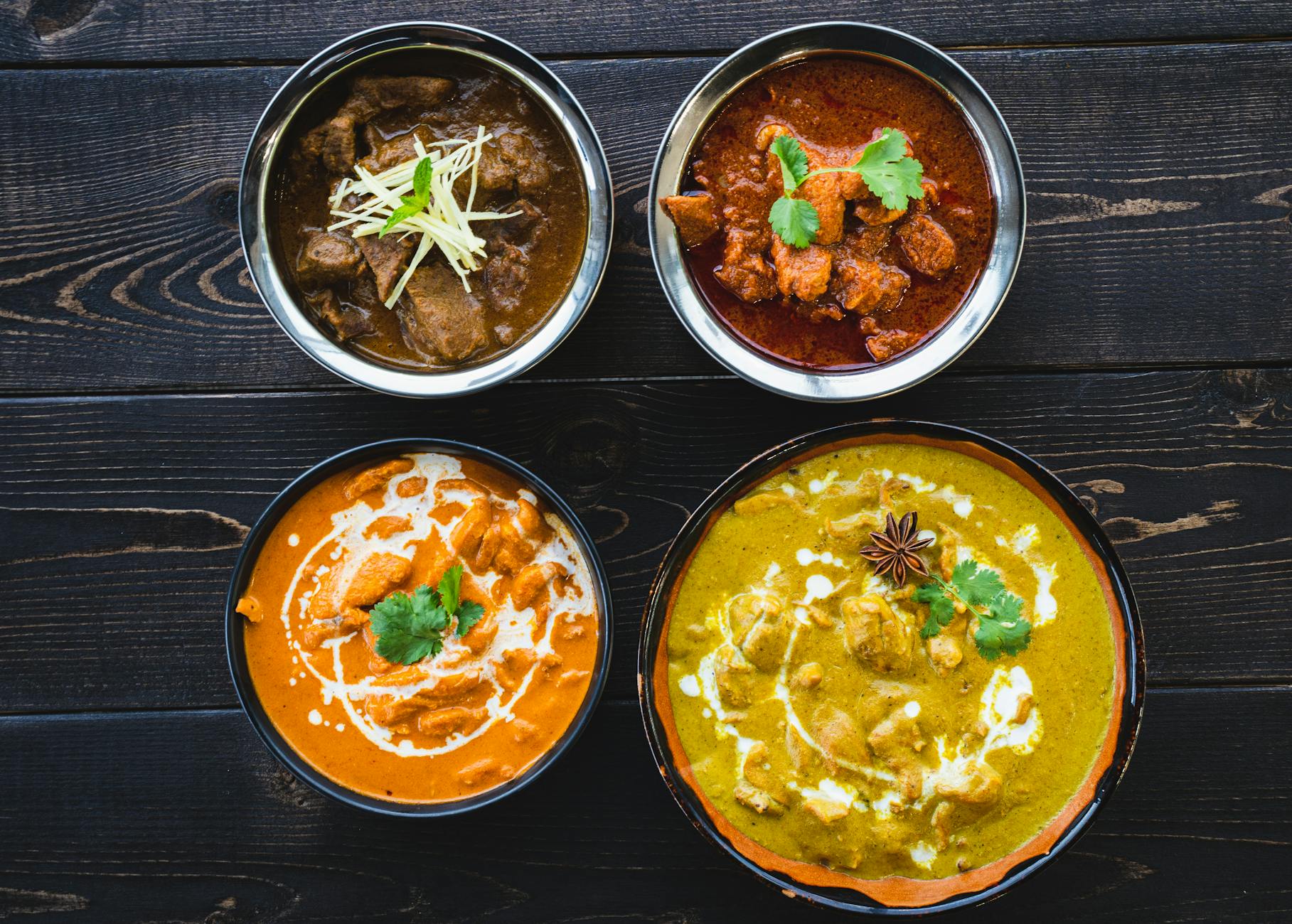
Photo by Alberta Studios
Side Dishes: Suggest complementary sides such as raita, salad, or chutneys
The sides you choose can either enhance the flavors of the dish or provide a refreshing balance to its rich and spicy profile.
- Raita: This yogurt-based side dish—often mixed with cucumber, mint, or boondi—helps to cool your palate while complementing the bold spices. It’s the culinary equivalent of hitting “refresh.”
- Chutneys: Add a tangy or sweet note with chutneys like mango, tamarind, or mint-cilantro. Their vibrant flavors act as accents to the main dish.
- Salads: A crisp kachumber salad, made with finely chopped cucumbers, tomatoes, onions, and a splash of lemon juice, provides a refreshing crunch and nutritional boost.
Looking for more ideas? See Yellow Thyme’s guide on side pairings.
Beverage Pairings: Provide ideas for drinks that pair well, like lassi, beer, or wine
Pair your Chicken Tikka Masala with the right drink to round off the meal, whether you’re looking to complement the flavors or cool down the heat.
- Lassi: Sweet or salted, this yogurt-based drink not only quenches your thirst but also balances the richness of the curry. Mango lassi is a favorite for its fruity, creamy taste.
- Beer: Light, crisp beers like lagers or IPAs bring a refreshing counterpoint to the spice and creaminess. The bubbles act as palate cleansers between bites.
- Wine: A slightly acidic or fruity wine like Riesling or a light Pinot Noir pairs beautifully. Avoid overly tannic wines, as they might clash with the spices.
For additional drink inspiration, check out AlcoEats’ beverage guide.
Pairing Chicken Tikka Masala with the right set of sides and drinks elevates the enjoyment, creating a balanced and unforgettable meal.
Chicken Tikka Masala’s Popularity in Pop Culture
Chicken Tikka Masala isn’t just a dish—it’s a phenomenon. Beyond its creamy, spicy charm, this beloved creation has a cultural staying power that transcends borders. It holds a spot not only on menus but also in movies, TV, and cultural diplomacy. Here’s how it found its way into the heart of pop culture.
Representation in Restaurants
You can’t walk into an Indian restaurant anywhere in the world without finding Chicken Tikka Masala on the menu. This creamy, flavorful dish has become synonymous with Indian cuisine and is often seen as an entry point for those new to South Asian food. But how did it rise to this level of ubiquity? Many credit its adaptability—it’s mild enough for Western palates yet retains its rich, authentic roots.
- Global Menu Star: Indian restaurants in countries like the UK, US, and Australia prominently feature Chicken Tikka Masala as a flagship dish. It symbolizes the perfect balance between traditional Indian cooking and global culinary appeal. According to Tastewise, it remains a staple on approximately 2.05% of restaurant menus globally.
- Accessible and Approachable: Its creamy texture and moderate spice level make it approachable for diners unfamiliar with Indian cuisine. This adaptability has allowed it to bridge culinary gaps and become a menu essential from New York to Tokyo.
Mentions in Media
From the silver screen to the pages of books, Chicken Tikka Masala has made its mark as both a plot device and a cultural reference.
- Movies: The 2005 British comedy-drama Chicken Tikka Masala humorously explores themes of identity and cultural expectations while taking its name from the iconic dish. As one critic observed, “the title alone points to the cultural fusion it aims to address.” IMDb’s trivia page notes its cultural importance in representing the Indian diaspora in Western mainstream media.
- Books: In literature, Chicken Tikka Masala frequently surfaces as a cultural touchstone. For instance, the children’s book Kaya and Sai Explore Chicken Tikka Masala introduces young readers to the dish while discussing cultural integration, making food a pathway for identity and understanding.
- TV Shows: In popular shows like The Hundred-Foot Journey, the fusion of Indian and Western cuisines—where Chicken Tikka Masala often plays a starring role—becomes a metaphor for bridging gaps between cultures. A Day In The Life On The Farm breaks down similar media influences.
Culinary Diplomacy
Chicken Tikka Masala is more than just food; it’s a symbol of cultural fusion and diplomacy. It has become a metaphor for the way societies integrate and influence one another.
- A National Statement: In 2001, British Foreign Secretary Robin Cook famously described Chicken Tikka Masala as “a true British national dish,” emphasizing its role in multicultural Britain. This moment highlighted how food can unify diverse identities and be a beacon of collective pride. Read more about this in Reclamation Magazine.
- Bridging Borders: As a product of Indian and British culinary collaboration, Chicken Tikka Masala exemplifies how food fosters cross-cultural connections. Whether served in a Glasgow pub or a Delhi food festival, it speaks the universal language of flavor.
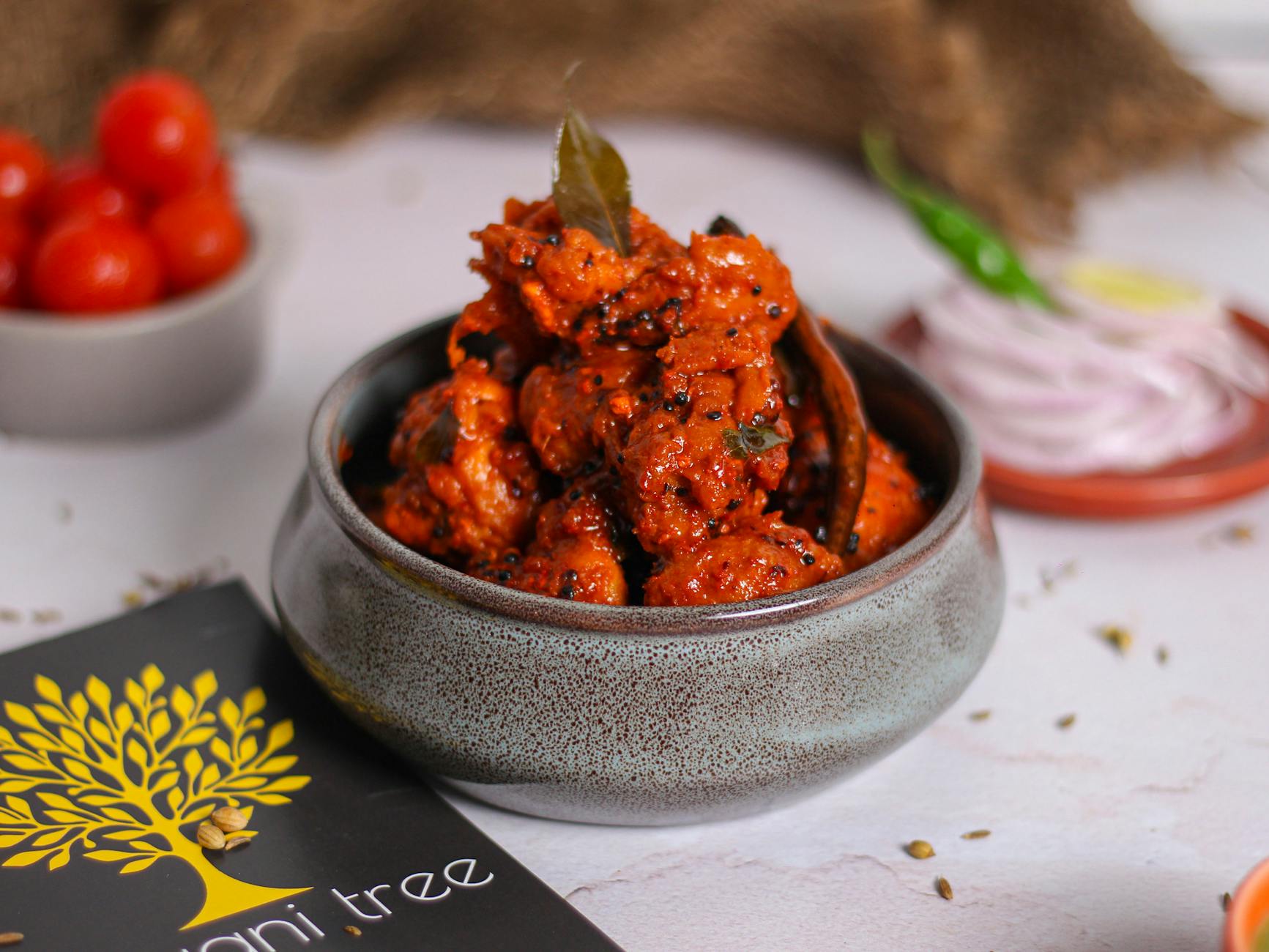
Photo by Prabal Pratap Singh
Chicken Tikka Masala is not just a meal; it’s a cultural icon. Its ability to charm taste buds and tell stories across different platforms is a testament to its significance as a unifier in an ever-diverse world.
"Looking for easy meal prep ideas high in protein? We've got you covered with simple, delicious recipes to keep you energized and on track!"
Conclusion
Chicken Tikka Masala is more than a dish—it’s a testament to the power of flavor to bring cultures together. From its roots in Indian tandoori traditions to its rise as a beloved global favorite, this curry tells a story of innovation and fusion.
Its creamy, spiced appeal and endless variations make it a versatile addition to any table. Whether you stay classic, try plant-based alternatives, or explore regional adaptations, Chicken Tikka Masala welcomes everyone to enjoy its unique charm.
Why not bring this iconic dish into your home? Experiment in the kitchen, try new twists, and share the experience with friends or family. What’s your favorite way to enjoy Chicken Tikka Masala? Let us know!

